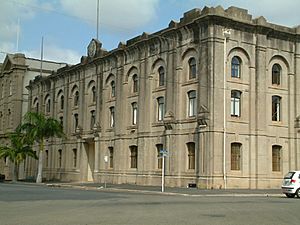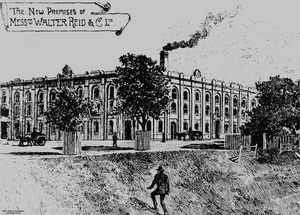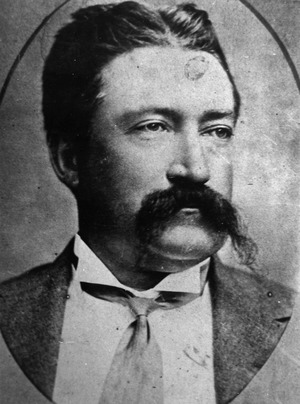Walter Reid Court facts for kids
Quick facts for kids Walter Reid Court |
|
|---|---|

Walter Reid Court, 2004
|
|
| Location | 260 Quay Street, Rockhampton, Rockhampton Region, Queensland, Australia |
| Design period | 1870s - 1890s (late 19th century) |
| Built | 1893 - c. 1918 |
| Architect | Richard Gailey |
| Official name: Walter Reid Court, Walter Reid & Co | |
| Type | state heritage (built) |
| Designated | 21 October 1992 |
| Reference no. | 600815 |
| Significant period | 1890s (fabric) 1893-1970s (historical use) |
| Significant components | courtyard |
| Lua error in Module:Location_map at line 420: attempt to index field 'wikibase' (a nil value). | |
Walter Reid Court is a historic building in Rockhampton, Queensland, Australia. It used to be a large warehouse but has now been turned into apartments. The building is located on Quay Street, right by the Fitzroy River.
It was designed by architect Richard Gailey and built between 1893 and about 1918. This building, also known as Walter Reid & Co., is an important part of Queensland's history. It was added to the Queensland Heritage Register in 1992.
Contents
The Story of Walter Reid Court
Walter Reid Court was built for a company called Walter Reid & Co. in 1893. It was designed by a famous architect named Richard Gailey. This three-storey brick building was one of two big warehouses built by Walter Reid in Rockhampton.
Walter Reid's Business Begins
Walter Reid started his business in Rockhampton in 1862. He first managed a retail store, then bought it in 1864. In 1868, he moved his business to Quay Street. Here, he started to focus on selling goods in large amounts (wholesale). He sold wine, spirits, and other items to hotels and farms in central Western Queensland.
Rockhampton became an official port in 1858. This made it a very important trading hub for central Queensland. This was a great place for wholesale merchants like Walter Reid to grow their businesses.
Growing the Business Empire
Walter Reid's business did very well as the colony grew. In 1867, the Central Western railway line was built. This connected Rockhampton to towns in western Queensland. This made Rockhampton even more important as a port.
Reid also started using small boats called lighters. These boats carried goods down the Fitzroy River to Keppel Bay. There, larger ships from overseas would unload their cargo. Walter Reid's company also worked as a local agent for British companies. In 1881, a British company called McIlwraith & McEachearn bought Walter Reid's business.
Walter Reid & Co. Expands
The new owners kept the name Walter Reid & Co. In the 1880s, the company made about £50,000 each year. They sold many different things, including groceries, drinks, tools, farm goods, and stationery. They also imported and exported goods. They were also agents for insurance, stocks, and other services.
By 1890, the business had grown so much that they needed a new building.
Building the New Warehouse
In December 1892, plans were made for a new warehouse in Rockhampton. Brisbane architect Richard Gailey designed it. Gailey was a very busy architect in Queensland in the late 1800s. He designed many warehouses in Brisbane and other port cities.
The Walter Reid & Co. warehouse cost about £12,000 to build. It was finished in 1893. Walter Reid & Co. then moved into their new head office and warehouse. In 1895, some changes were made inside the building. Rockhampton architects Eaton & Bates designed a new entrance and office areas.
Rockhampton's Boom Years
Walter Reid & Co. did very well in the 1880s. This was a time of great wealth in Rockhampton. Gold mining at Mount Morgan from 1882 brought a lot of money to the city. The company's success helped it survive tough times later. This included the economic downturn of the 1890s and a drought in the early 1900s.
In 1902, Walter Reid & Co. built a second warehouse. This one is now the Walter Reid Community Arts Centre. It was finished in 1904 and designed by Hutton & Hockings. These large warehouses showed how important Walter Reid was as a trading company in central Queensland.
Further Growth and Changes
Walter Reid & Company kept growing. They imported goods directly from England, America, Europe, and India. They built new stores for produce and wool. In 1904, they took over other businesses in Brisbane and Mackay. They even opened an office in Sydney in the 1910s.
The 1893 warehouse changed a lot during this time. On October 11, 1912, a fire started by lightning badly damaged the warehouse. Only a small part of the building was saved. The fire showed that the original design had large open spaces inside. These spaces allowed the fire to spread quickly.
The building was rebuilt after the fire. It's possible the open courtyard was added then. There was another fire in 1918, which also led to more rebuilding inside.
The Warehouse During Wartime
During World War II, both Walter Reid & Co. warehouses were used by U.S. troops. Many American soldiers were based in Rockhampton. They used many buildings in the city. Walter Reid & Co. still used the warehouse during this time.
A New Chapter for the Building
Walter Reid & Co. was strong enough to keep going even when the port became less busy. However, by the 1970s, the company faced problems in its grocery business. Shopping habits had changed since the 1950s. The company decided to stop selling groceries wholesale. It moved to North Rockhampton and changed its name to 'Reid's'.
Both of Walter Reid & Co.'s main warehouses in Rockhampton were sold in the 1970s. In 1979, the Quay Street building was bought by a church group. They wanted to turn it into a hospital. The inside of the building was emptied for this plan, but it didn't happen.
In 1980, the building was sold again. The new owners planned to turn it into apartments. In 1981, it was sold to another group of investors. The new apartments, now called Walter Reid Court, opened in 1983.
What Walter Reid Court Looks Like
Walter Reid Court is a three-storey building made of brick with a smooth, unpainted cement finish. It stands on the corner of Quay and Derby Streets. It is separated from the Walter Reid Community Arts Centre by Quay Lane.
The building is shaped like a "U". It has brick walls inside that create an enclosed courtyard space. Most of the original inside parts of the building are gone. However, the outside looks much the same. Some of the early inside brick walls that form the courtyard are also still there.
The building now has strong concrete floors and support columns. It has 16 apartments, a swimming pool, a sauna, and parking spaces.
Outside Features
The outside of the building has evenly spaced sections. These sections are separated by pillars that stick out slightly. The building has a clear base. Lines in the cement separate the ground, first, and second floors.
The roof is hidden behind a decorative wall called a parapet. This wall has small pillars with pointed tops. In the middle of the parapet, there is a shield-shaped decoration. It shows the company's name and coat of arms. The name WALTER REID AND COMPANY LIMITED is also written on a decorative band (frieze) on the Quay and Derby Street sides.
The Quay and Derby Street sides have tall, recessed arches on each section. These arches frame the windows. The windows on the top floor are arched, while the lower floors have flatter arches. The ground floor windows have security bars. All the windows have been replaced with modern ones.
Entrances and Details
On the Derby Street side, there is a vehicle entrance with a roller door. There is also an entrance to a private apartment. These entrances have decorative gablets (small gables) above them.
The main entrance to the apartments is on the Quay Street side. It has a glass door and a fanlight (a window above the door). The name WALTER REID COURT is written above it.
The Quay Lane side of the building looks similar to the Derby Street side. However, the ground floor has several roller doors. The windows on this side have old metal-framed windows with wired glass.
The back of the building (northwest side) has no windows in the middle. It has three sections at each end. The parapet details are similar to the front. The company's name is also on the frieze at each end.
Inside the Apartments
The building has one, two, and three-bedroom apartments. There is a large games area on the first floor. A solarium (a room with lots of windows) is on the second floor. The apartments face Quay and Derby Streets. Common areas face Quay Lane.
The driveway entrance on Derby Street leads to a courtyard. This courtyard has car parking and access to a garage. You can also get to the courtyard from the Quay Street entrance through a corridor.
The courtyard is surrounded by old brick walls. These walls show where original openings used to be. Now, they have metal-framed windows on the upper levels. Large openings have been made on the ground floor for garage access. Metal walkways and stairs go around the courtyard. They provide access to the apartments and are also fire escapes.
Why Walter Reid Court is Important
Walter Reid Court was listed on the Queensland Heritage Register in 1992. It is important for several reasons:
A Glimpse into Queensland's Past
Walter Reid Court shows how much trade and business grew near the Rockhampton wharves in the late 1800s. This building is a reminder of Rockhampton's importance as a busy port city. Along with the nearby Walter Reid Community Arts Centre, it is part of a group of old warehouses that are still very well preserved.
Unique Building Style
The building's unpainted cement finish is quite rare to see today. It was a common way to finish buildings back then, but not many examples have survived.
Beautiful and Recognizable
Walter Reid Court is a very noticeable building. It looks impressive because of its large size and long sides facing the street. It is a well-known landmark in Rockhampton. It adds a lot to the city's look. Its design and materials show great skill.
Special to the Community
The building is a special landmark for the people of Rockhampton. It helps create the city's unique image and history.
Connected to Important People and Companies
The building is strongly linked to Walter Reid & Co. This company was very important in Queensland's economy in the late 1800s and early 1900s. It also shows the work of Richard Gailey. He was a leading architect in Queensland for many years.
Images for kids






